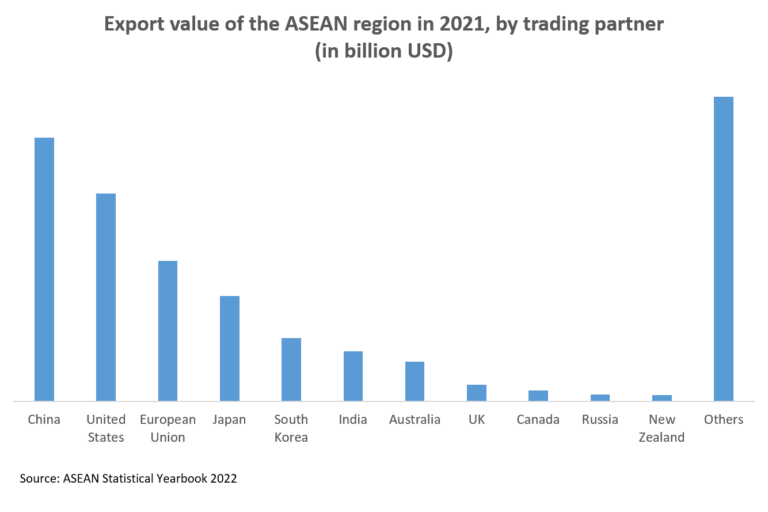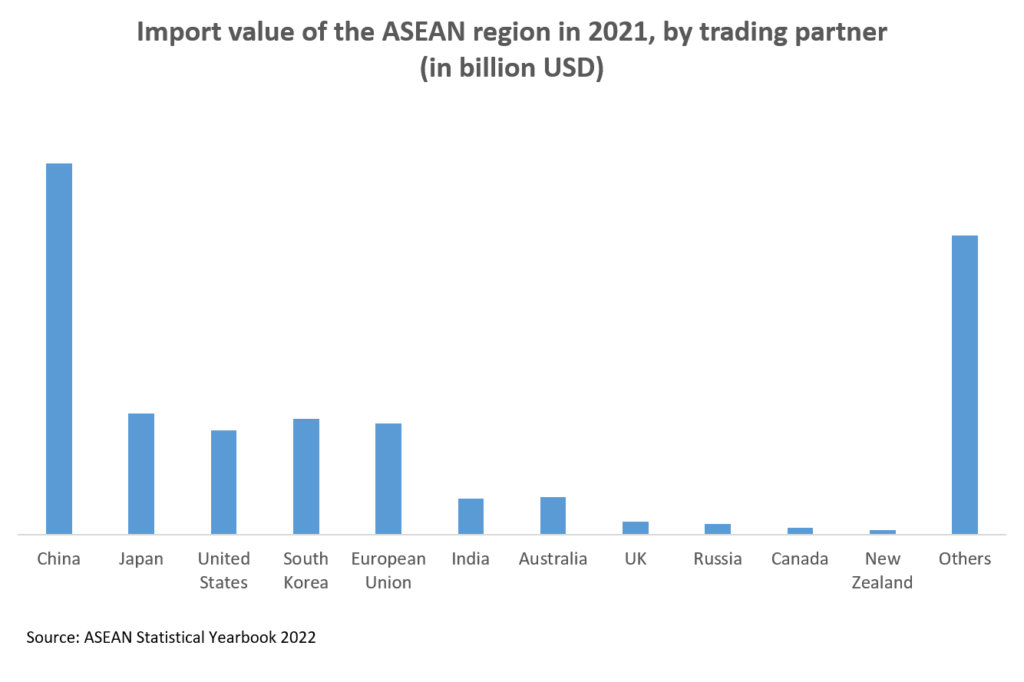ASEAN FREIGHT AND LOGISTICS MARKET - GROWTH, TRENDS AND FORECASTS (2023-2028)
Download Free Sample
Industry Definition
Key Figures
Total Number of Companies in ASEAN: 795,497
Number of Companies in Transportation and Warehousing Sector in ASEAN: 38,399
Market Size of the Freight and Logistics Market: ~USD xx
Inquire before buying!
Download Free Sample
Brief on the ASEAN Freight and Logistics Market
The ASEAN Freight and Logistics Market is estimated to grow with a compounded annual growth rate of about xx% during the forecast period of 2023-2028.
- Southeast Asia has established itself within a web of advantageous trade agreements, both with other Asian nations as well as with Europe and North America. It is situated at the meeting point of two of the biggest free trade agreements in the world: the Comprehensive and Progressive Agreement for Trans-Pacific Partnership, which includes Malaysia, Singapore, and Vietnam, and the Regional Comprehensive Economic Partnership, which includes all of Southeast Asia.
- ASEAN is the fastest-growing trading group in the world and currently represents about 8% of all exports, demonstrating the benefits of its audacious embrace of openness and internationalism. As reported in November 2022, ASEAN makes up close to 10% of worldwide inbound foreign direct investment, matching mainland China in size.
- Logistics is becoming increasingly complicated and important in horizontal and vertical integration as ASEAN thrives on being the commercial and economic centre region. While ASEAN strives to strengthen connectivity through a variety of modalities and access to ports, sophisticated logistics services, and qualified personnel in all facets of supply chains, investors are being provided with a wide range of opportunities by the regional government.
- To speed up cargo clearances and increase corporate transparency, the ASEAN Single Window has been introduced that connects and unifies the National Single Windows of the region’s member states. The region’s nations are currently testing the interchange of intra-ASEAN certifications of origin and ASEAN customs declaration documents.
- Due to the increasing transportation requirements in the market, ASEAN gives regional connectivity initiatives top priority. The ASEAN Highway Network (AHN) will link airports, seaports, and other locations with significant investment and tourism potential. It has 23 approved routes with a combined length of nearly 38,400 kilometres. On the other side, the Singapore-Kunming Rail Connection will travel through railway stations and related infrastructure in Singapore, Malaysia, Thailand, Cambodia, Vietnam, and China (Kunming).
- ASEAN is making an attempt to interact with other prospective Indo-Pacific allies in an effort to balance relations between the US and China. Economic ties between India and ASEAN have benefited from the geopolitical relationship’s growth; ASEAN is currently India’s fourth-largest commercial partner, with USD 98.39 billion in the period April 2021- February 2022 in bilateral trade.
Spotlight on Manufacturing Sector
- According to a recent survey, manufacturing conditions in the ASEAN area improved in September 2022 at the fastest rate in nearly a year. The ASEAN manufacturing sector’s overall purchasing managers’ index (PMI) increased from 52.3 in August 2022 to 53.5 in September 2022.
- According to the most recent S&P Global PMI statistics, businesses indicated steeper gains in output, new orders, purchasing activity, and employment, while company confidence remained historically robust. Moreover, the rate of expansion was excellent overall and the fastest since October 2021. However, by December, the PMI fell to 50.3 backed by the softened demand as an impact of the economic recession expected during the forecast period.
- Southeast Asian countries are specialized in certain industries. Major industries include Electronics (Vietnam, Malaysia, Singapore), Textiles/apparel (Vietnam, Philippines), Automotive (Thailand, Indonesia), Petrochemical products (Thailand, Indonesia, Malaysia), and Agricultural products (Vietnam, the Philippines, Indonesia, Thailand).
- Governments in the region are investing in infrastructure and advanced manufacturing capabilities while also reforming the legal and trade frameworks to make doing business easier. Companies looking to move their production or supply chain hubs to SEA can take advantage of incentives including tax holidays and cash awards.
- The quick acceptance of new technologies, the ongoing construction of cutting-edge infrastructure facilities, and the creation of a sharing-based economic model are further positive aspects. These factors add together to make SEA a desirable location for growing supply chain and manufacturing capabilities.
- In 2021, ASEAN, the seventh-largest automobile manufacturing hub in the world, produced 3.5 million vehicles, up from 2.85 million in 2020. Somewhere between 2023 and 2024, ASEAN car production is anticipated to reach the levels it had before COVID-19. The autos produced in ASEAN are marketed in the region’s domestic markets and exported to countries like Australia, New Zealand, and the Middle East.


Competitive Landscape
- The ASEAN Freight and Logistics Market is fragmented, having a mix of significant global and domestic businesses. With a significant number of local players and several major players, the countries in the region are exploring their expanding capabilities with the developing economies and growing trade relations; among which, due to the abundance of foreign competitors, the marketplaces in Singapore, Vietnam, and Thailand are extremely competitive.
- Consuming processed food and having higher standards of hygiene are two tendencies that are on the rise in the ASEAN region. As a result, there are a tonne of chances for new players to enter the market in sectors including the production of refrigerated vehicles, the supply of temperature control equipment, and cold chain consulting.
- Industry sources claim that DHL occupies a key position in the AEAN freight and logistics market accompanied with DB Schenker, Yusen Logistics, and Kerry Logistics Network Limited among others.
Why buy this report on the ASEAN Freight and Logistics Market?
UPKR Intelligence market research reports enable you to:
- Understand the market
- Pinpoint the key industry trends
- Identify threats and opportunities
- Quickly build competitive intelligence
This report on ASEAN Freight and Logistics Market:
- Provides the data on economic status of ASEAN region, trade relations, modal engagement and market size information to assist with planning and strategic decisions.
- It helps you understand market dynamics to give you a deeper understanding of industry competition and the supply chain.
- Analyses key performance and operational metrics so that you can benchmark against your own business, that of your customers’ businesses, or your competitors’ businesses.
The ASEAN Freight and Logistics Market research report includes:
- Analysis of the important factors influencing this industry’s history, including data
- Five-year market projection and trends identified
- For the primary products and markets, thorough research and segmentation
- Analysis of key players in the market, their shares and the competitive environment
UPKR Intelligence is a market research company fully concentrated on the logistics domain. We cover the entire market including the dynamic trends, various segments and the market competition via the analysis of the companies operating in the market to arrive at conclusions to aid the needs of our clients.
Table Of Content
- Market Overview
- Economic Overview of ASEAN
- Overview on ASEAN Freight and Logistics Market
- Market Dynamics
- Market Drivers
- Restraints
- Value Chain Analysis
- Porter’s Five Forces Analysis
- Government Regulations and Initiatives
- Technological Developments in the Market
- Spotlight on Freight Rate in ASEAN
- Impact of COVID-19 on the Market
- Market Segmentation
- By Function
- Freight Transport
- Forwarding
- Warehousing
- Value-Added Services
- By End-Users
- Manufacturing
- Oil and Gas
- Distributive Trade
- Construction
- Healthcare
- Other End-Users
- By Country
- Indonesia
- Thailand
- Singapore
- Malaysia
- Rest of ASEAN
- By Function
- Competitive Landscape
- Market Concentration Overview
- Company Profiles (list not exhaustive)
- Outlook and Opportunities in the Market
- Appendix
- GDP Distribution and Growth by Economic Activities
- Inflation Statistics
- Contribution of the Transport and Storage Sector to GDP
- External Trade Statistics – Export and Import, by Product
- Key Import and Export Destinations
Related Reports
- ASEAN Multimodal Freight Transport Market – Growth, Trends and Forecasts (2023-2028)
- ASEAN Road Freight Transport Market – Growth, Trends and Forecasts (2023-2028)
- ASEAN Air Freight Transport Market – Growth, Trends and Forecasts (2023-2028)
- ASEAN Rail Freight Transport Market – Growth, Trends and Forecasts (2023-2028)
- ASEAN Sea Freight Transport Market – Growth, Trends and Forecasts (2023-2028)
- ASEAN Third-Party Logistics (3PL) Market – Growth, Trends and Forecasts (2023-2028)
- ASEAN Fourth-Party Logistics (4PL) Market – Growth, Trends and Forecasts (2023-2028)
- ASEAN Same Day Delivery Market – Growth, Trends and Forecasts (2023-2028)
- ASEAN Express Delivery Market – Growth, Trends and Forecasts (2023-2028)
- ASEAN Last Mile Delivery Market – Growth, Trends and Forecasts (2023-2028)
- ASEAN CEP Market – Growth, Trends and Forecasts (2023-2028)
- ASEAN Warehousing and Distribution Market – Growth, Trends and Forecasts (2023-2028)
- ASEAN Automotive Logistics Market – Growth, Trends and Forecasts (2023-2028)